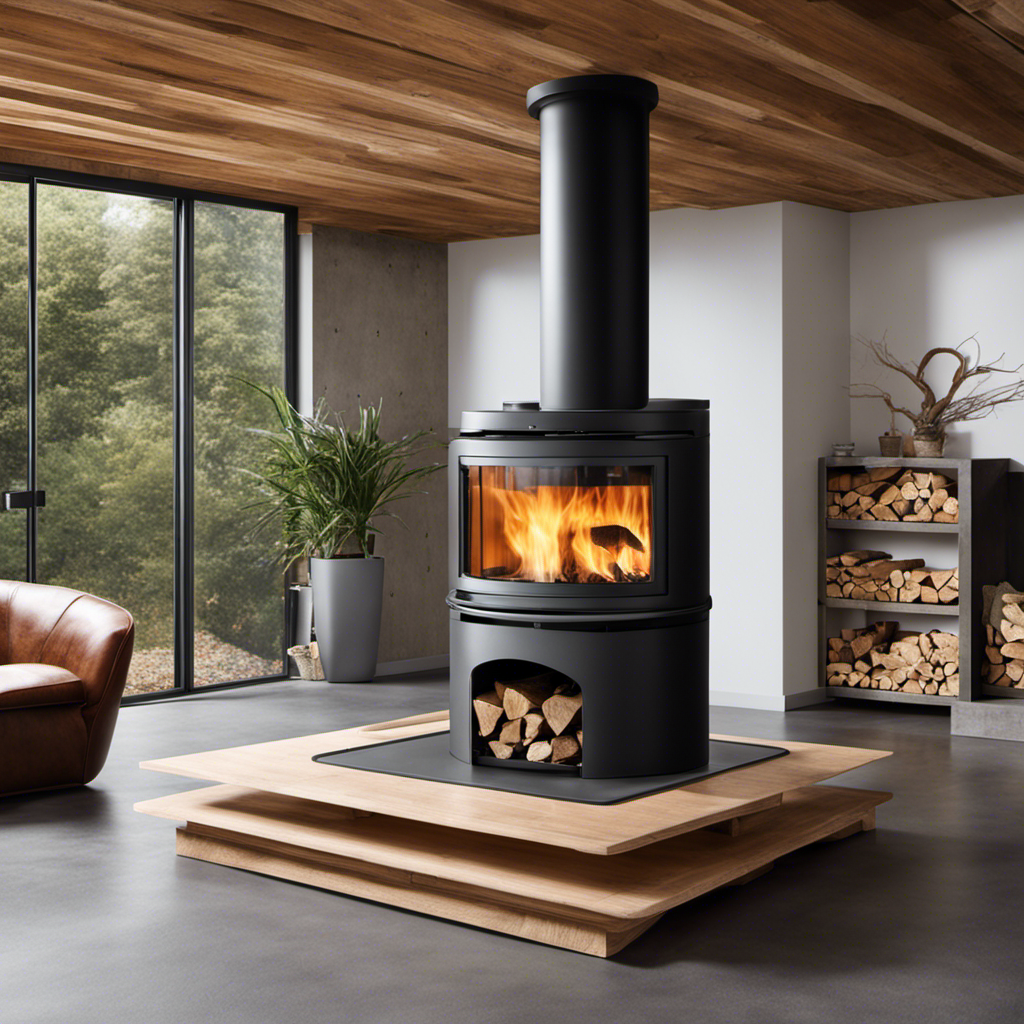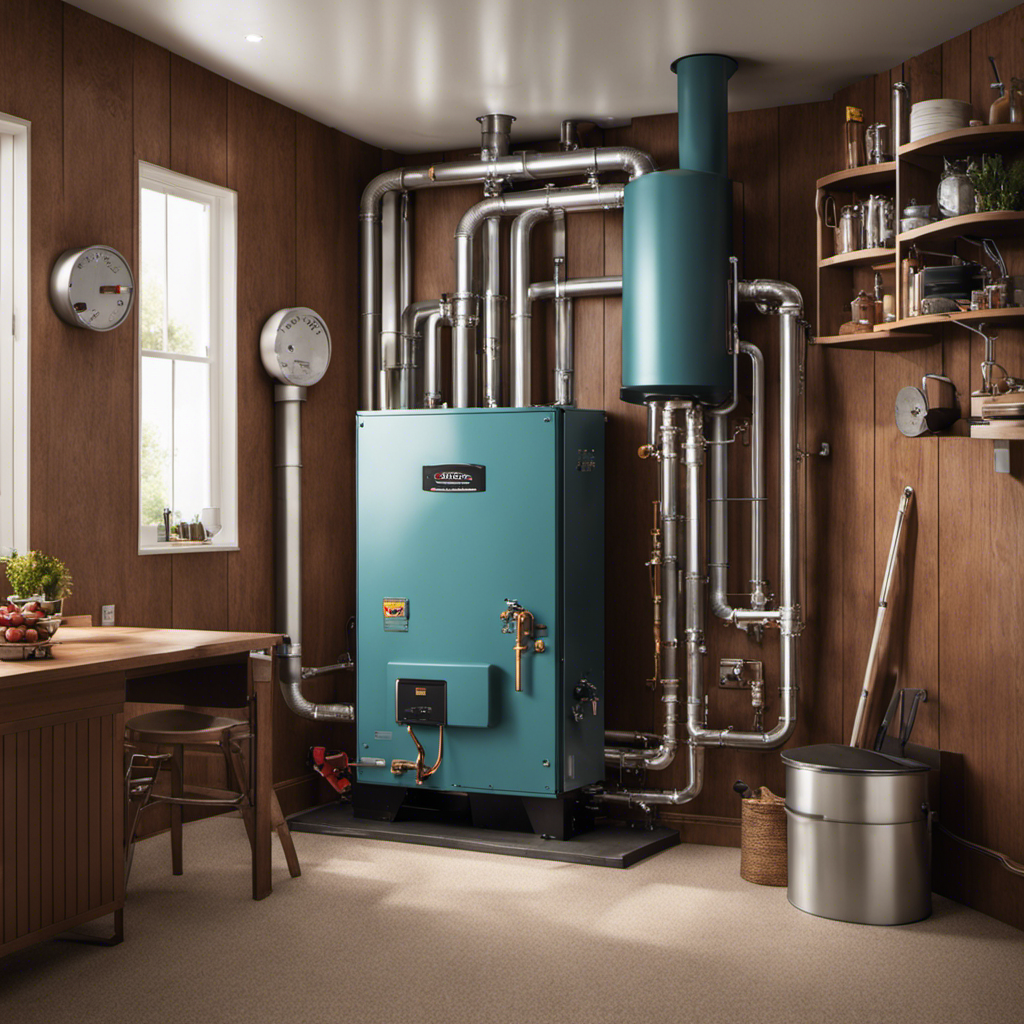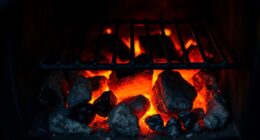Following the saying, ‘Don’t let your warm air go to waste!’
In this article, I’ll be sharing some valuable insights on how to prevent heated air from escaping up the chimney when your wood stove is not in use.
From understanding the chimney draft to installing a draft stopper, I’ll guide you through various solutions to retain heat efficiently.
So, let’s dive in and discover the benefits of maintaining a sealed chimney.
Key Takeaways
- The chimney draft is affected by temperature differences and the height and diameter of the chimney.
- Dampers play a crucial role in controlling airflow and retaining heat in the chimney.
- Installing a draft stopper can prevent heat loss and save energy.
- Alternative solutions such as opening windows, using insulation materials, and installing a damper or draft stopper can effectively reduce heat loss and conserve energy.
Understanding the Chimney Draft
I can feel the warmth coming down from above, and it helps me understand the chimney draft. The chimney draft is the flow of air up and out of the chimney, which is crucial for the proper functioning of a fireplace or wood stove. Understanding the mechanisms behind the chimney draft is essential for maintaining a safe and efficient heating system.
There are several factors that can affect the chimney draft. One important factor is the temperature difference between the inside and outside of the chimney. As the warm air rises, it creates a pressure difference that pulls air up the chimney. Another factor is the height and diameter of the chimney. A taller and narrower chimney will create a stronger draft.
Additionally, factors such as wind direction and obstructions near the chimney can also influence the chimney draft. Wind blowing against the chimney can disrupt the flow of air, while obstructions like trees or nearby buildings can create a downdraft.
Understanding these chimney draft mechanisms and factors can help homeowners optimize their heating systems and ensure efficient and safe operation.
The Role of Dampers in Heat Retention
While I understand the importance of the chimney draft, it is crucial to also consider the role of dampers in heat retention. Dampers are an essential component for controlling airflow in chimneys, and they play a significant role in improving energy efficiency. By adjusting the damper, homeowners can regulate the amount of air that escapes through the chimney, preventing the loss of heated air when the wood stove or fireplace is not in use. This simple mechanism helps to trap warm air inside the home, reducing energy consumption and lowering heating costs. To illustrate the benefits of dampers in heat retention, consider the following table:
| Without Damper | With Damper |
|---|---|
| Heat loss through chimney | Minimal heat loss |
| Higher energy consumption | Lower energy consumption |
| Increased heating costs | Reduced heating costs |
Installing a Draft Stopper: Step-by-Step Guide
Installing a draft stopper is a simple and effective way to prevent heated air from escaping through the chimney when the wood stove isn’t in use. To ensure a successful installation, there are a few key tips to keep in mind.
First, measure the dimensions of your chimney accurately to choose the right draft stopper size. It should fit snugly and cover the entire opening.
Next, select a draft stopper made of durable materials that can withstand the heat generated by the stove. Silicone or rubber are popular choices.
When installing, make sure to clean the chimney thoroughly and remove any debris or obstructions. Attach the draft stopper securely and test it by lighting a match near the edges to check for any leaks.
With these simple tips, you can prevent heat loss and save on energy costs.
Now, let’s explore some alternative solutions to prevent heat loss.
Alternative Solutions to Prevent Heat Loss
Although it may seem counterintuitive, opening windows during the day can actually help prevent heat loss by allowing warm sunlight to enter and heat the room. However, when it comes to preventing heat loss from an unused wood stove, there are alternative solutions that can be implemented. One effective technique is to use insulating materials for chimney efficiency. These materials, such as chimney insulation blankets or ceramic insulation coatings, help to minimize heat transfer and prevent warm air from escaping through the chimney. Additionally, energy saving techniques for unused wood stoves include installing a damper or draft stopper to seal off the chimney when the stove is not in use. This prevents cold air from entering the room and warm air from escaping, resulting in significant energy savings. By implementing these strategies, homeowners can effectively reduce heat loss and conserve energy.
| Insulating Materials for Chimney Efficiency | Energy Saving Techniques for Unused Wood Stoves |
|---|---|
| – Chimney insulation blankets | – Installing a damper or draft stopper |
| – Ceramic insulation coatings | – Sealing off the chimney when not in use |
Benefits of Maintaining a Sealed Chimney
I’ve noticed that maintaining a sealed chimney can lead to significant energy savings and prevent heated air from escaping when the wood stove isn’t in use. Here are three reasons why this practice is advantageous and can result in savings:
-
Reduced energy consumption: By sealing the chimney, you can prevent warm air from escaping, which means your heating system doesn’t have to work as hard to maintain a comfortable temperature in your home. This can result in lower energy bills and significant savings over time.
-
Improved indoor air quality: A sealed chimney prevents outside pollutants, such as dust, debris, and insects, from entering your home. This helps to maintain better indoor air quality, which is crucial for your health and well-being.
-
Extended lifespan of the chimney: Regularly sealing the chimney can prevent moisture from entering, which can cause damage to the structure. By protecting the chimney, you can extend its lifespan and avoid costly repairs or replacements.
Frequently Asked Questions
How Can I Improve the Chimney Draft in My Wood Stove?
To improve the chimney draft in my wood stove, I’d start by troubleshooting any issues with the chimney, such as blockages or leaks. Additionally, improving chimney insulation can help prevent heated air from escaping when the stove is not in use.
What Are the Different Types of Dampers Available and How Do They Affect Heat Retention?
There are different types of dampers that can affect heat retention in a wood stove. They include manual, automatic, and bypass dampers. Each type has its own impact on energy efficiency.
What Materials Do I Need to Install a Draft Stopper for My Chimney?
To install a draft stopper for my chimney, I would need alternative materials like foam or inflatable plugs. Using a chimney cap has benefits such as preventing downdrafts, keeping out debris, and improving energy efficiency.
Are There Any Other Methods to Prevent Heat Loss From My Chimney Besides Using a Draft Stopper?
Alternative solutions to prevent heat loss from my chimney include installing an energy efficient chimney cap, using a damper to seal the chimney when not in use, and insulating the chimney with heat-resistant materials.
What Are the Advantages of Sealing My Chimney and How Does It Benefit the Overall Heating Efficiency of My Home?
Sealing your chimney has many advantages. It prevents heat loss, improves heating efficiency, and saves money on energy bills. By keeping the warm air inside, you can enjoy a cozy home and avoid wasting precious heat.
Conclusion
In conclusion, by installing a draft stopper in your chimney when your wood stove isn’t in use, you can prevent heated air from escaping and save on energy costs.
Did you know that according to a study by the U.S. Department of Energy, the average household loses up to 30% of its heat through air leaks?
By sealing your chimney, you can greatly reduce this heat loss and create a more energy-efficient home.
Logan’s affair with adventure began in childhood. He hailed from a small town where vast forests bordered one side and endless shores stretched on the other. His days were spent exploring uncharted woods, climbing tall trees, or listening to the tales of old sailors. This early immersion in a world brimming with stories and mysteries became the foundation of his passion for writing.











